

Study finds simple interventions can help certain online learners persist. Assuring learners from less developed countries that they belong and encouraging them to share their core values can help them succeed in online courses, researchers at the Massachusetts Institute of Technology and Stanford University have found.
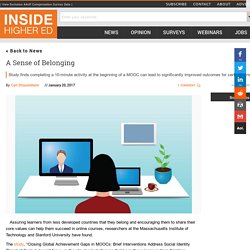
The study, “Closing Global Achievement Gaps in MOOCs: Brief Interventions Address Social Identity Threat at Scale,” doesn’t focus on the structural challenges that keep those learners from finishing massive open online courses, such as insufficient English language skills or internet access. Instead it looks at what MOOC designers and instructors can do to create an environment in an online course that tells learners they are able to do well regardless of their background. The findings, which suggest something as simple as a one-time, 10-minute exercise can double persistence and completion rates, joins research that has found at-risk learners need additional support when studying online.
The researchers, René F. ENISA report on blockchain technology and security. Blockchain is a distributed ledger which maintains all transactions and assets and is updated by a number of counterparties.

Financial institutions are investing in the technology - in what is hoped - to automate processes and remove “human” errors. This may help towards lowering transactional and operational costs by releasing the finance sector from its legacy systems. A World Economic Forum[1] report reveals that over one billion euros are invested in blockchain technology startups.
Despite the potential cost savings, it remains important to assess what the security implications of Blockchain implementations might be. ENISA analysed the technology and identified security benefits, challenges and good practices. 4 years later, Harvard and MIT offer review of MOOCs. Published Jan. 13, 2017 Dive Brief: Harvard University and MIT have released a report on what they've learned in the four years since the launch of massive online open courses in 2012, which the schools say have served more than 2 million users.

According to the study of more than 290 courses, the schools enrolled more than 1,500 unique participants daily over the measured period. The average learner in these courses was a 29-year-old male living outside of the United States.More than 30% of learners in MOOCs self-described as active or former teachers and more than 250,000 students earned certification through these programs. Ijlm a 000912. Starter kit final. Innovating pedagogy 2016. Study: Digital textbook codes can be as costly as traditional materials. Dive Brief: The New York Times reports on the growing costs associated with digital textbooks and learning materials, specifically access codes for tests and homework assignments.

A new survey of 10 colleges and universities shows the average access code, which sometimes are only found in purchased textbooks, costs $100 alone, increasing by only $26 when offered with a traditional text. The average annual amount students spend on materials has declined by $100 since 2008, to about $602. How to increase MOOC completion rates. Dive Brief: St.
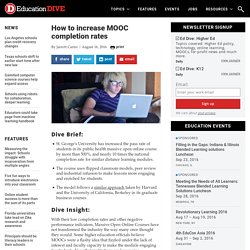
George's University has increased the pass rate of students in its public health massive open online course by more than 500%, and nearly 10 times the national completion rate for similar distance learning modules. The course uses flipped classroom models, peer review and industrial infusion to make lessons more engaging and enriched for students. The model follows a similar approach taken by Harvard and the University of California, Berkeley in its graduate business courses. The 10 Most Important Work Skills in 2020. Share this infographic on your site!
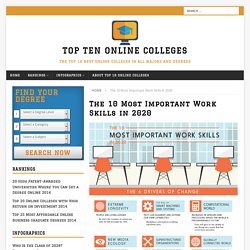
<a href=" src=" alt="Important Work Skills for 2020" width="500" border="0" /></a><br />Source: <a href=" OLC study: 90% students see online experience as good as face-to-face. MOOCS margaryan2015. MOOCs and quality a review of the recent literature. Is higher ed too preoccupied with the present to plan for the future?
Dive Brief: A new book by Jon McGee, vice president for planning and public affairs at the College of Saint Benedict and Saint John’s University in Minnesota, says higher education leaders need to step back from the demands of the present to plan for the future.
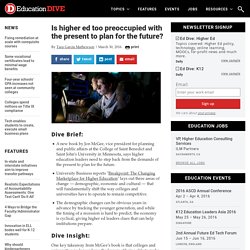
University Business reports "Breakpoint: The Changing Marketplace for Higher Education" lays out three areas of change — demographic, economic and cultural — that will fundamentally shift the way colleges and universities have to operate to remain competitive. The demographic changes can be obvious years in advance by tracking the younger generation, and while the timing of a recession is hard to predict, the economy is cyclical, giving higher ed leaders clues that can help institutions prepare. Setting-up a European Cross-Provider Data Collection on Open Online Courses.
EPALE. European Schoolnet. Learning Innovation - A Framework for Transformation.pdf. Hybrid Pedagogy Journal. The “crisis in the humanities,” whether unprecedented and dire or perpetual and overblown, plays out as a controversy over how long people like me will have a job, and whether we’ll be missed once we’re gone.
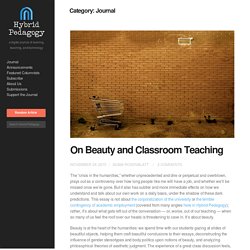
But it also has subtler and more immediate effects on how we understand and talk about our own work on a daily basis, under the shadow of these dark predictions. This essay is not about the corporatization of the university or the terrible contingency of academic employment (covered from many angles here in Hybrid Pedagogy); rather, it’s about what gets left out of the conversation — or, worse, out of our teaching — when so many of us feel the roof over our heads is threatening to cave in. It’s about beauty. In fact, there are many reasons for beauty to flee the scene. “To misstate, or even merely understate, the relation of the universities to beauty is one kind of error that can be made,” Scarry writes. Beauty is why we teach, and how we learn. Beauty is critical. Modernisation of Higher Education. Camilleri - State of the Art Review of Quality Issues related to Open Educational Resources (OER) Digital Media & Learning.
Digital Media & Learning Strategy. Rationale Our society is in the midst of a reinvention of how knowledge is created, organized, accessed, and shared that has far-reaching implications for institutions of learning – schools, libraries, museums, and more.

Digital media offers the promise of a new learning system that acknowledges and nurtures individual talents, skills, and interests. JRC Review of Open Education Resources. NMC Horizon Report 2013 Higher Education Report. Open University Innovating Pedagogy 2013. Educational Technology and Change Journal. Education Technology. Innovating Pedagogy.